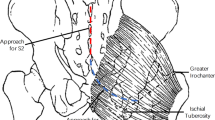Abstract
Twenty-one sides of 11 adult Japanese cadavers were investigated, and 2 of 21 sides exhibited absence of the pyramidalis. We observed that all of the nerves to the pyramidalis included the sensory nerve branch, which distributed to the aponeurotic tissue in the upper area of the pubic ramus. To investigate the clinical relevance and developmental process of the pyramidalis, detailed innervation patterns of the pyramidalis and the lumber plexus were examined and compared with the case of absent pyramidalis. The nerves to the pyramidalis could be classified into five types by the derivative nerves and two subtypes by their courses associated with the funiculus spermaticus. In the cases of absent pyramidalis, similar sensory branches distributed close to the upper area of the pubic ramus. We deduced that the sensory branch extended along with the muscular branch to the pyramidalis after development of the pyramidalis and that only the sensory branch remained in cases in which the pyramidalis disappeared. The two subtypes might associate with descensus testis. Surgeons performing inguinal hernia repair using a mesh and tension-free surgical technique should preserve the nerves around the funiculus spermaticus to avoid diminished proprioception in the lower abdominal wall.








Similar content being viewed by others
References
Adachi B (1909) Beitrage zur Anatomie der Japaner. Die Staristik der Muskelvarietaten. Zeieschrift Morph Anthropol 12:261–312
Akita K, Sakamoto H, Sato T (1993) Innervation of the anteromedial muscle bundles of the gluteus medius. J Anat 182:433–438
Ando T (1938) Rectus abdominis and triquetrous muscle in twin fetus. In: Taniguchi T (ed) Anatomical study of twin fetus 2. National Diet Library, Tokyo pp 1–30 (in Japanese)
Anson BJ, Beaton LE, McVay CB (1938) The pyramidalis muscle. Anat Rec 72:405–411
Arakawa T, Sekiya S, Kumaki K, Terashima T (2006) Intramuscular nerve distribution pattern of the oblique and transverse heads of the adductor hallucis muscles in the human foot. Anat Sci Int 81:187–196
Ashley-Montagu MF (1939) Anthropological significance of the musclus pyramidalis and its variability in man. Am J Phy Anthropol 25:435–490
Bardeen CR (1902) A statistical study of the abdominal and border nerves in man. Am J Anat 1:203–228
Garvey JW (2012) Computed tomography scan diagnosis of occult groin hernia. Hernia 16:307–314
Grossi JVM, Cavazzola LT, Breigeiron R (2015) Inguinal hernia repair: can one identify the three main nerves of the region? Revista do Colégio Brasileiro de Cirurgiões 42:149–153
Jeremiah CH, Neil RB (2005) Abdomen and pelvis. In: Standring S (ed) Gray’s anatomy, 39th edn. Churchill Livingstone, New York, pp 1101–1112
Kawai M (1939) Uber den M. pyramidalis bei den japanischen Ewachsenen und Foten, bensonders die Grosses desselben. Acta Anat Nippon 9:182–197 (in Japanese with a German abstract)
Kodama K (1986) Morphological significance of the supracostal muscles, and the superficial intercostal nerve: a new definition. Kaibougaku Zasshi 61:107–129 (in Japanese with an English abstract)
Konno T, Konari T (1955) M. pyramidalis ce japanoj. Ntidalishi 14:1526–1530 (in Japanese with an Esperanto abstract)
Kumaki K (1995) Nerves of lumber plexus that demarcate the transition from abdominal wall to lower limb. In: Horiguchi M, Kida M, Kodama K (eds) Anatomy of peripheral nerves, vol 1. Basic and Application, Science Communications, Tokyo, pp 147–156 (in Japanese)
Lewis WH (1910) The development of the muscular system: the muscles of the trunk. In: Keibel F, Mall F (eds) Manual or human embryology, vol 1. J. B. Lippincott Company, London, pp 473–478
Lovering RM, Anderson LD (2008) Architecture and fiber type of the pyramidalis muscle. Anat Sci Int 83:294–297
Moore KL, Persaud TVN, Torchia MG (eds) (2013) Urogenital system. The developing human: clinically oriented embryology, 9th edn. Saunders, Philadelphia, pp 245–288
Natsis K, Piagkou M, Repousi E, Apostolidis S, Kotsiomitis E, Apostolou K, Skandalakis P (2016) Morphometric variability of pyramidalis muscle and its clinical significance. Surg Radiol Anat 38:285–292
Skręt-Magierło J, Soja P, Drozdzowska A, Bogaczyk A, Szczerba P, Gora T, Skręt A (2015) Two techniques of pyramidalis muscle dissection in Pfannenstiel incision for cesarean section. Ginekol Pol 86:509–513
Swanson GJ, Lewis J (1986) Sensory nerve routes in chick wing buds deprived of motor innervation. J Embryol Exp Morphol 95:37–52
Tokita K (2006) Anatomical significance of the nerve to the pyramidalis muscle: a morphological study. Anat Sci Int 81:210–224
Tsutsumi M, Arakawa T, Terashima T, Miki A (2015) Intramuscular nerve distribution pattern in the human tibialis posterior muscle. Anat Sci Int 90:104–112
Umezu T (1949) Rectus abdominis and pyramidalis muscle in twin fetus. Acta Anat Nippon 24:109 (in Japanese)
Yamada TK (1986) Re-evaluation of the flexor digitorum superficialis. Kaibougaku Zasshi 61:283–298 (in Japanese with an English abstract)
Acknowledgements
The authors gratefully thank Prof. emeritus Toshio Terashima, Prof. emeritus Katsuji Kumaki, Prof. Yukio Aizawa, Dr. Tomiyoshi Setsu, and Mr. Yoshiaki Sakihama for their technical assistance and kind advices. The authors also thank the members of our laboratory for their cooperation. The authors express special thanks to the donors of the cadavers used in this study and their families. Financial support for this study was provided by JSPS KAKENHI grant no. 17K01501.
Author information
Authors and Affiliations
Corresponding author
Ethics declarations
Conflict of interest
The authors declare that they have no conflict of interest.
Rights and permissions
About this article
Cite this article
Haba, D., Emura, K., Watanabe, Y. et al. Constant existence of the sensory branch of the nerve to the pyramidalis distributing to the upper margin of the pubic ramus. Anat Sci Int 93, 405–413 (2018). https://doi.org/10.1007/s12565-018-0428-z
Received:
Accepted:
Published:
Issue Date:
DOI: https://doi.org/10.1007/s12565-018-0428-z




